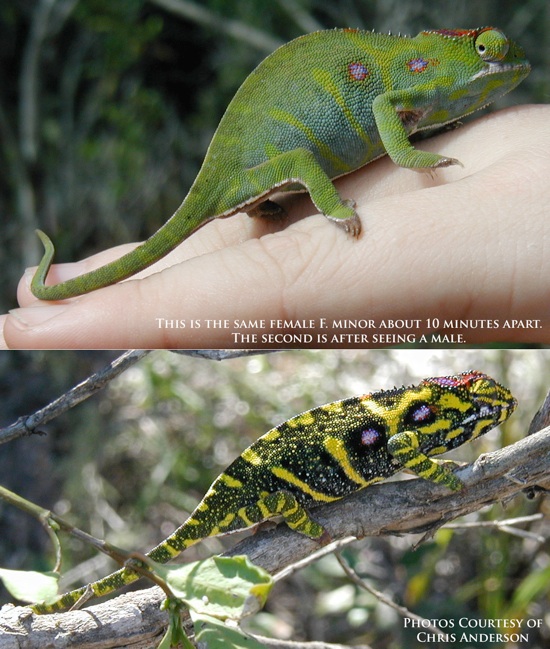



Historic and Contemporary Theories on Chameleon Color Change
By Christopher V. Anderson
Citation:
Anderson, C.V. (2004). Historic and Contemporary Theories on Chameleon Color Change. Chameleons! Online E-Zine, November 2004. (http://www.chameleonnews.com/04NovAndersonColor.html)
One of the chameleon's foremost characteristics is the ability to change color. Historically, there have been significant debate regarding the cause of such color change and the mechanics responsible for this ability that the chameleon is so well known for. Often, the causes for this behavior were only briefly mentioned and in vague terms. Sadly, misconception continues to plague this feature today.
Aristotle provided the first notes of zoological significance on the ability of the chameleon to change color. In his first mention of the phenomenon, he attributed the changing of color to the character of fear. In later writings, Aristotle attempted to provide a theory on the mechanism by which chameleons are able to change color. This mechanism he described was inflation, which he said caused the skin to darken.
The inflation theory was one of two major competing theories regarding the mechanism of chameleon color change up until the 1840s. The basic principles of the inflation theory relate to the blood and to the lower layers of skin under a more transparent outer epidermal skin layer. This theory believes that brightly colored blood and the hidden color of lower skin layers cause the variation in color in chameleons as they range in proximity to the epidermis. One of the possibilities presented within this theory is that brightly colored blood present under the epidermis is forced toward the surface and based on the amount packed into the area under the outer layer of skin, the color of the chameleon changes. The variation in the concentration of the blood under the epidermis was considered to change based on the pressure on the cavities or vessels containing them. This was attributed to tension and relaxation of nerves in the surrounding tissue as well as the pressure change as the lungs inflate and deflate. This theory was challenged as time went on by observations that appearance of patterns frequently occurred in the exact same spot time and again. If there was a flow of the blood under the skin that was responsible for this change, these skin patterns and color would be homogeneous. A second possibility in this theory is that during a relaxed state with the epidermal skin slightly folded, these folds hide the colors of the lower layers of skin. As the chameleon extends its ribs and inflates its lungs, these outer folds in the skin become tight, exposing the color of the lower skin layers. As the tension in the skin varies, so to does the color of the chameleon as we see it. This theory was displaced, however, by observations that periods of color change occurred in the absence of inflation and that inflation could occur without color change.
The second major competing theory on the chameleon color changing mechanism was the suffusion theory. This theory dictated that there was an ebb and flow below the outermost layer of skin of colored matter that causes the color change in chameleons. Notes were made that while the chameleon would change color at various times, the skin had a base color under the superimposed color patches. Excretion of colorful bile to the skin surface to collect in particular regions and then its reabsorption was presented as one explanation. Explanations dictating the release of various pigmented fluids, from bodily viscera, under the skin in particular places were widespread. Unfortunately, technology to accurately determine the cause was not available during much of this speculation.
With the appearance of the technology to examine the skin closely, in the form of better microscopes, Milne-Edwards was able to provide the most accurate observations on chameleon color change up to that point. To begin with, he was able to show that color changes were not caused by inflation as mentioned previously. According to this theory, by stretching the skin, the dark pigment of the lower skin layers should come to view through the upper surface but in stretching the skin, this did not occur. Through further examination of the skin, he was able to conclude that there were two separate pigments acting on the color change, a dark pigment located in the lower layer of skin and a yellowish surface pigment. He believed that during the life of the chameleon, with the lower dark pigment moving its concentrations within the layers of skin, the occurrence of color change occurred. One discovery he made that aided his discovery was that alkaline solution removed the color from the surface layer of skin in specimens. He examined a skin sample treated in alkaline solution and noted that the dark color of the skin was contained in numerous small hollow spaces in lower portions of the skin. He then observed that each cavity had a number of branches extending toward the surface of the skin. He explained that the low layer concentrations of dark pigment could likely travel up these branches and were then placed intermittently amongst the second pigment he described, thereby altering the color. He was describing what would later be called chromatophore cells.
With further technological advances, we now know more about chromatophores and chameleon skin properties. Chameleon skin is now known to have three types of chromatophore cells. The deepest layer of chromatophore cells, which are what was described by Milne-Edwards, are melanophores which contain black pigment. These cells have an array of branches spreading toward the surface of the skin called dendrites or dentritic processes. Located just above the melanophores are guanophores, also known as iridophores, which are responsible for blue colors as light reflects off the colorless guanine crystal platelets within them. The uppermost layer of chromatophore cells are xanthophores which are responsible for the yellow and red pigmentations. The granules of pigment within chromatophore cells selectively reflect and absorb certain wavelengths of light. In melanophores, these pigment granules are capable of differentially spreading within the dentritic processes altering their concentrations within the skin and the interactions they have with light reflecting off other pigments. With exhibition of different concentrations of each pigment, the external coloration we see changes. The actions of these chromatophores are synchronized by neurological and hormonal control mechanisms that respond to stimulus from the central nervous system as it obtains feedback from skin receptors and various other sensory organs.
The science behind the color change is interesting but many wished to understand why chameleons do so. Early speculations regarding the cause of this behavior varied. Many believed it was an involuntary response to fear that was not affected by the colors of their surroundings. Antigonus Carystius, a Greek writer, was the first to claim that the chameleon, similar to the octopus, changed color to match the color of whatever it was on. In addition to theories about emotion and background causing the color changes, acknowledgement by some that light intensity or angle and temperature might affect the color change began to appear. Thankfully, by the late 1500s and early 1600s, the belief that chameleons could attain any color and that they changed based on their background had been scientifically discounted.
Currently, we know that chameleons change color for a combination of causes. The intensity of external light is one major factor. As explained above, the selective absorption and reflection of light rays from the different chromatophore pigments and their interactions cause color variation. Furthermore, chameleons tend to alter their color from light to dark when they are overly cool or warm respectively. Finally, a combination of emotional and physiological responses cause significant color change. These include, but are not limited to, gravidity, stress, illness, fear, discontentment and responses to the presence of other animals whether they be the same or different species or the same or different sex.
While historically there has been much debate over the “How?” and “Why?” of chameleon color change, it is astounding that beliefs still remain that were scientifically discounted between the 1500s and 1800s. For one of the most recognized traits of the chameleon, color change is also one of the most misunderstood and more complex features of these amazing animals.

References:
Best, A.E.(1968): The discovery of the mechanism of colour-changes in the chameleon. Ann. Of Sci. 24: 147-167.
Bradbury, J.W. & Vehrencamp, S.L.(1998): Principles of Animal Communication. Sinauer Associates, Inc. Massachusetts.
Necas, P.(2004): Chameleons-Nature's hidden jewels. Zoo Book Sales, MN, USA.

Christopher V. Anderson

Chris Anderson is a herpetologist currently working on his Ph.D. at the University of South Florida after receiving his B.S. from Cornell University. He has spent time in the jungles of South East Asia, among other areas, aiding in research for publication. He has previously traveled throughout Madagascar in search of, and conducting personal research on, the chameleons of the region. He has traveled to over 35 countries, including chameleon habitat in 6. Currently, Chris is the Editor and Webmaster of the Chameleons! Online E-Zine and is studying the kinematics and morphological basis of ballistic tongue projection and tongue retraction in chameleons for his dissertation. Chris Can be emailed at Chris.Anderson@chameleonnews.com or cvanders@mail.usf.edu.









Join Our Facebook Page for Updates on New Issues:
© 2002-2014 Chameleonnews.com All rights reserved.
Reproduction in whole or part expressly forbidden without permission from the publisher. For permission, please contact the editor at editor@chameleonnews.com
